|
Pontiac Solstice
Debut: 2005
Maker: General Motors
Predecessor: no |
|
 In
January 2002, GM showed a concept roadster in Detroit motor show. It
was Pontiac Solstice. At the time, most people, including me, did not
believe GM would put the great-looking concept roadster into
production. But we were wrong. GM product director Bob Lutz made a
brave decision to put it into development, giving it a new dedicated
sports car platform called Kappa. This platform is going to be used
only by the Solstice and sister car Saturn Sky. It will be produced at
a rate of 20,000-30,000 cars a year, priced at US$20,000 and target
directly at the mighty Mazda MX-5. The car is finally born 3 years
later. In
January 2002, GM showed a concept roadster in Detroit motor show. It
was Pontiac Solstice. At the time, most people, including me, did not
believe GM would put the great-looking concept roadster into
production. But we were wrong. GM product director Bob Lutz made a
brave decision to put it into development, giving it a new dedicated
sports car platform called Kappa. This platform is going to be used
only by the Solstice and sister car Saturn Sky. It will be produced at
a rate of 20,000-30,000 cars a year, priced at US$20,000 and target
directly at the mighty Mazda MX-5. The car is finally born 3 years
later.
The Solstice undertakes the mission to revive the Pontiac brand as an
exciting American performance brand. Whether this mission impossible
can be accomplished is not optimistic to me, but the car itself
definitely worth applause. In most areas, the Solstice runs close to
the new Mazda MX-5. This is undoubtedly the best effort from Pontiac
for years, not even the mid-engined Fiero sports car of the 1980s can
match its achievement.
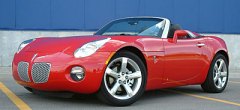 The
Solstice really looks great. It's radical, aggressive and
expressive in typical American way. Compare with its Mazda arch-rival
it is far more emotional and attractive, making the Mazda bland and
boring. Its body has the same short length as the MX-5, but is much
wider (by 9 cm) and longer in wheelbase (by 8.5 cm). It also has bigger
(18-inch vs 17-inch) wheels wrapping with astonishingly wide rubbers
(245/45 vs 205/45). No wonder it looks more muscular and sportier. The
Solstice really looks great. It's radical, aggressive and
expressive in typical American way. Compare with its Mazda arch-rival
it is far more emotional and attractive, making the Mazda bland and
boring. Its body has the same short length as the MX-5, but is much
wider (by 9 cm) and longer in wheelbase (by 8.5 cm). It also has bigger
(18-inch vs 17-inch) wheels wrapping with astonishingly wide rubbers
(245/45 vs 205/45). No wonder it looks more muscular and sportier.
The
soft roof of Solstice is not as convenient to operate as the MX-5,
because it needs you to go outside, open the boot lid, drop the roof
into the boot and close the lid again. In contrast, Mazda's roof can be
operated by the driver in his seat - no other manual cabriolet roof is
easier to use like this one. However, the Pontiac's roof seals and
insulates very well. It also has a glass rear window with defrost
heater, so it gives you no cheap feeling like many other American
convertibles.
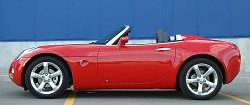 Thanks to the longer wheelbase
and wider body, the Solstice provides
more leg and shoulder room than the MX-5. Headroom is also abundance
with the roof up, because Bob Lutz is 6ft 4 tall. On the contrary to
its Japanese rival, the dashboard design is radical but plastic quality
is poor. Neither can the fit and finish match Mazda's. Luckily, the
chrome-ringed gauges looks smart. Thanks to the longer wheelbase
and wider body, the Solstice provides
more leg and shoulder room than the MX-5. Headroom is also abundance
with the roof up, because Bob Lutz is 6ft 4 tall. On the contrary to
its Japanese rival, the dashboard design is radical but plastic quality
is poor. Neither can the fit and finish match Mazda's. Luckily, the
chrome-ringed gauges looks smart.
The Kappa architecture is designed purely for low-volume sports cars.
Without Bob Lutz, I think GM would have opted for a cheap front-drive
platform shared with other GM mass production cars. Kappa employs a
longitudinally-mounted straight-4 engine and drives through its rear
wheels like all classic roadsters. Most of the engine is mounted behind
the front axle, thus GM calls it a front-mid-engined car. This,
however, cannot match Mazda MX-5, which has the whole engine located
behind the front axle and achieves 50:50 balance. In the Pontiac case,
front-to-rear weight distribution is 52:48, still a good figure.
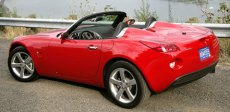 The Kappa architecture does
not employ conventional monocoque chassis,
but a frame chassis built on two hydroformed steel rails running the
north-south of the car. Then the windscreen frame, bulkhead, firewall
and boxed transmission tunnel are welded to the rails to form a stiff
structure. Sports car-dedicated double-wishbones suspensions are
attached to all four corners. Then covered with hydroformed steel body
panels. Because of MIG welding, the whole production process is human
intensive thus is only suitable to low volume production. The Kappa architecture does
not employ conventional monocoque chassis,
but a frame chassis built on two hydroformed steel rails running the
north-south of the car. Then the windscreen frame, bulkhead, firewall
and boxed transmission tunnel are welded to the rails to form a stiff
structure. Sports car-dedicated double-wishbones suspensions are
attached to all four corners. Then covered with hydroformed steel body
panels. Because of MIG welding, the whole production process is human
intensive thus is only suitable to low volume production.
Unlike
the chassis, the powertrain comes from GM's parts pool: the 2.4-litre
inline-4 engine comes from Chevrolet Cobalt etc., the 5-speed gearbox
comes from Chevy Colorado pickup (though with improved shift
mechanism), while the rear differential and brakes come from Cadillac
CTS.
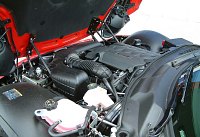 The four-cylinder engine has
twin-balancer shafts to damper vibration
while dual VVT to boost power and torque, which is 177 hp / 6600 rpm
and 166 lbft / 4800 rpm respectively. Compare with MX-5's smaller
2-litre engine, the Pontiac provides just 7 more horsepower, but an the
advantage of 26 lbft of torque nearly compensates the loss of a gear
and the extra 200 kg kerb weight. This means the Solstice is marginally
slower against the clock (it takes about 7.5 seconds from rest to 60
mph) but feels more relaxed when cruising, because its engine does not
need to rev as hard as the MX-5. The four-cylinder engine has
twin-balancer shafts to damper vibration
while dual VVT to boost power and torque, which is 177 hp / 6600 rpm
and 166 lbft / 4800 rpm respectively. Compare with MX-5's smaller
2-litre engine, the Pontiac provides just 7 more horsepower, but an the
advantage of 26 lbft of torque nearly compensates the loss of a gear
and the extra 200 kg kerb weight. This means the Solstice is marginally
slower against the clock (it takes about 7.5 seconds from rest to 60
mph) but feels more relaxed when cruising, because its engine does not
need to rev as hard as the MX-5.
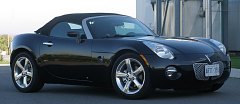 However, by sports car standard
the long-stroke 2.4 engine is not good
enough. This kind of engine might work flawlessly in a Toyota Camry or
Honda Accord, but in a pure sports car it lacks the eagerness,
responsiveness and rev-happy manner that keen drivers ask for. However, by sports car standard
the long-stroke 2.4 engine is not good
enough. This kind of engine might work flawlessly in a Toyota Camry or
Honda Accord, but in a pure sports car it lacks the eagerness,
responsiveness and rev-happy manner that keen drivers ask for.
Ditto the 5-speed manual gearbox GM does not have a suitable
6-speed
manual gearbox in its parts pool, so it chose a 5-speeder. It is not a
bad transmission, but the widely separated ratios do not help
quickening engine response and the shift quality cannot match the likes
of MX-5 and Honda S2000, which are slicker and crisper.
The Solstice weighs 1300 kg because its chassis and body are all steel.
In return, the extra kerb weight and high chassis stiffness contribute
to a competent handling and ride quality. Its suspension feels firmer
than the MX-5 but on uneven surfaces it is more compliant and tide down
to the road. In corners it resists roll better than the Mazda and its
245/45 rubbers provide superior grip.
 Is that
meaning the Pontiac has won the handling contest? the answer is yes
until approaching the limit. At the limit, the Solstice tends to
understeer more than the Mazda - it does not have enough power to break
the strong rear grip. You can regain neutrality by easing off the
throttle like in the Mazda, albeit in a more inert manner. The MX-5's
skinny tires and better weight distribution make it always feel sharper
and more sensitive to steering / throttle input. This means it delivers
more driving fun while the Solstice feels more secured. Is that
meaning the Pontiac has won the handling contest? the answer is yes
until approaching the limit. At the limit, the Solstice tends to
understeer more than the Mazda - it does not have enough power to break
the strong rear grip. You can regain neutrality by easing off the
throttle like in the Mazda, albeit in a more inert manner. The MX-5's
skinny tires and better weight distribution make it always feel sharper
and more sensitive to steering / throttle input. This means it delivers
more driving fun while the Solstice feels more secured.
In the steering department, the Solstice's hydraulic steering is
precise and nicely weighted (luckily it did not employ electric
assistance). It resists kickback from the road better than the MX-5's
but delivers slightly less feel.
Undeniably, GM has done a fine job to produce Pontiac Solstice. It is
just not good enough to shake the winning status of Mazda MX-5. Give it
a better gearbox and more powerful turbocharged engine and it might be
another story. The chassis is obviously capable to take more power, so
I won't be surprised if GM launch a hotter Solstice in the future.
Before that, the base Solstice is still capable of capturing a lot of
sales because it is more sexy and a better cruiser than the MX-5, and
runs it close in most other areas. |
| The
above report was last updated on 29 Sep
2005. All Rights Reserved. |
Saturn Sky
|
 
Saturn
Sky is the badge-engineered sister car to Pontiac Solstice. Basically,
only the clothes and tuning differ them. The Sky’s exterior design was
derived from Vauxhall VX Lightning concept car penned by Simon Cox in
England. As the Vauxhall version did not get the go-ahead, Saturn
reused it from the recycle bin. Compare to the organic, wild Solstice,
the Saturn looks crisper, cleaner and more tasteful. Inside, it also
got a more stylish center console, with piano-black surface to lift the
quality feel, though the rest of the cabin is still full of cheap
plastics.
To prevent from internal competition, GM prices the Saturn higher than
the Pontiac, but it offers more standard equipment to justify the price
hike. The Saturn is tuned to be slightly more comfortable and refined,
thanks softer and longer suspension travel, better
hood insulation and quieter exhaust. While it rides more comfortable
than Solstice, there is virtually no tradeoff in handling.
It seems that the extra time for development paid off in the Saturn.
However, both cars share the same 2.4-litre 177hp power plant and
5-speed gearbox, so performance is neck to neck. Overall, the Sky is a
better car than Solstice, although both trail Mazda MX-5.
Later this year, the Sky will be exported to Europe under the name Opel
GT. |
| The
above report was last updated on 12 May
2006. All Rights Reserved. |
Solstice GXP and Saturn Redline
|
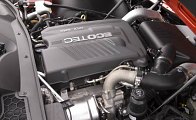 Learning
that the weakest link
of Pontiac Solstice and Saturn Sky is their 2.4-liter 16V engine, we
are glad to see GM introduces a more powerful version for both,
Solstice GXP and Sky Redline. As both cars share the same engine,
gearbox, chassis… tires and even the same suspension setup, we can
combine both in the same report. Learning
that the weakest link
of Pontiac Solstice and Saturn Sky is their 2.4-liter 16V engine, we
are glad to see GM introduces a more powerful version for both,
Solstice GXP and Sky Redline. As both cars share the same engine,
gearbox, chassis… tires and even the same suspension setup, we can
combine both in the same report.
 Focus here is the new
2.0-liter turbocharged Ecotec 16V engine. Having
aluminum block and head, twin-cam 16 valves, continuous variable valve
timing at both intake and exhaust valves, direct gasoline injection,
twin-balancer shafts and a twin-scroll BorgWarner K04 turbocharger, you
won't believe it is a product of GM, who still builds pushrod V8s
today. Thanks to a heavy turbo boost (max 1.2 bar) and direct
injection, it produces an outstanding 260 horsepower from only 1998 cc,
accompany with a wide spread of torque reaching 260 lbft from 2500 to 5200 rpm. The only
other engine having such versatility I can think of is the latest Audi
S3 (265 hp and 258 lbft). Focus here is the new
2.0-liter turbocharged Ecotec 16V engine. Having
aluminum block and head, twin-cam 16 valves, continuous variable valve
timing at both intake and exhaust valves, direct gasoline injection,
twin-balancer shafts and a twin-scroll BorgWarner K04 turbocharger, you
won't believe it is a product of GM, who still builds pushrod V8s
today. Thanks to a heavy turbo boost (max 1.2 bar) and direct
injection, it produces an outstanding 260 horsepower from only 1998 cc,
accompany with a wide spread of torque reaching 260 lbft from 2500 to 5200 rpm. The only
other engine having such versatility I can think of is the latest Audi
S3 (265 hp and 258 lbft).
However,
the
horsepower measurement method by GM must be different from Audi.
Theoretically, Solstice GXP and Sky Redline should do 0-60 mph in 5.5
seconds and 0-100 mph in 13.9 seconds easily. In fact, a couple of
magazines expressed that the test cars did not seem to produce as much
punch. One of them was Car and Driver, which measured 5.6 seconds and
14.9 seconds respectively using its typically fast launching technique.
This is not at all slow, but neither it is as quick as its horsepower
and weight figures suggested.
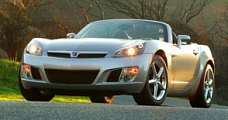 That said, we care
more about quality than quantity. The GM engine loses more marks here.
While it is as smooth as its balance shafts suggested, while its turbo
conversion muted the coarse noise of the original engine, its throttle
response is annoyingly slow and there is moderate turbo lag. The
combination of the two means there is a long delay from stepping the
throttle to the emergence of motive power. Without an immediate
throttle response, in addition to an annoyingly long travel pedal, GXP
and Redline are not the roadsters you would like to play throttle steer
in corners. That said, we care
more about quality than quantity. The GM engine loses more marks here.
While it is as smooth as its balance shafts suggested, while its turbo
conversion muted the coarse noise of the original engine, its throttle
response is annoyingly slow and there is moderate turbo lag. The
combination of the two means there is a long delay from stepping the
throttle to the emergence of motive power. Without an immediate
throttle response, in addition to an annoyingly long travel pedal, GXP
and Redline are not the roadsters you would like to play throttle steer
in corners.
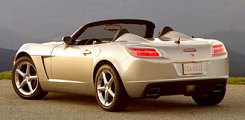 In fact, the calibration of
nearly all controls are problematic. The
5-speed Aisin gearbox is heavy and sticky, no match with Mazda MX-5's
quick and slick 6-speeder. The 2.7-turn steering is slow and
non-linear. The understeer gets worse because of the heavier nose (now
weight distribution is shifted from 52:48 to 54:46). The same brakes as
the normally aspirated car do not match the upgraded performance. There
is a set of grippier Goodyear F1 Eagle and slightly stiffer suspension
setup, but we can't see any improvements to handling. Luckily, the ride
remains good, and the direct injection turbo engine is slightly more
frugal than the 2.4 engine. In fact, the calibration of
nearly all controls are problematic. The
5-speed Aisin gearbox is heavy and sticky, no match with Mazda MX-5's
quick and slick 6-speeder. The 2.7-turn steering is slow and
non-linear. The understeer gets worse because of the heavier nose (now
weight distribution is shifted from 52:48 to 54:46). The same brakes as
the normally aspirated car do not match the upgraded performance. There
is a set of grippier Goodyear F1 Eagle and slightly stiffer suspension
setup, but we can't see any improvements to handling. Luckily, the ride
remains good, and the direct injection turbo engine is slightly more
frugal than the 2.4 engine.
The other flaws share with the base cars, namely, poor quality cabin,
no cabin storage, small boot and the inconvenient roof operation.
Summing all up, Solstice GXP and Sky Redline are disappointing. They
looked promising when details came out from January's Detroit motor
show, but unfortunately the execution was poor. An MX-5 may be much
slower, but it will put more smile on your face. |
| The
above report was last updated on 21 Sep
2006. All Rights Reserved. |
|
|